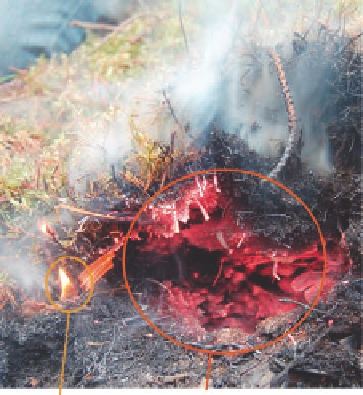Geology Reference
In-Depth Information
Flaming
Smouldering
Figure 17.1.2. Photo of the two regimes of combustion of solid fuels: flaming grass on top of peat and smoldering
peat. The flame is about 10mm high. Photo by Guillermo Rein, 2006 (Rein et al., 2008).
reaction and partially lost to the environment. The oxidizer is transported to the reaction zone by diffusion and
convection, in turn feeding the oxidation reactions. Once ignition occurs, the reaction advances gradually
through the material.
The transition from smoldering to flaming fires is of concern in coal mines and when subsurface fires reach the free
surface. This transition is a spontaneous gas-phase ignition supported by the smolder reaction which acts both as
the source of gaseous fuel (pyrolysate, CO, etc.) and of heat to carry the reaction. The transition occurs when
critical conditions inside the pores of the solid are met, triggering the onset of gas-phase reactions (flaming). These
conditions include the flammability of the gas mixture inside the pores and a net excess of heat released by strong
solid-phase oxidation reactions. Increased levels of oxygen and airflow (e.g., caused by wind) can strongly
influence transition. But currently understanding of the process is rather limited.
When studying smoldering propagation through the interior of combustible materials, it is common to consider
the simpler one-dimensional process and to classify it in two main configurations: opposed and forward
propagation. These are defined according to the direction in which the smolder reaction propagates relative to the
oxidizer flow. Figure 17.1.3 shows the two one-dimensional configurations. In opposed smolder, the reaction front
Forward flow
Air
Virgin
foam
Reacted
foam
Reaction zone
Opposed flow
Air
Virgin
foam
Reacted
foam
Reaction zone
Figure 17.1.3. Configurations in one-dimensional smoldering; forward, and opposed. Illustration by Guillermo
Rein, 2005 (Rein et al., 2006).


